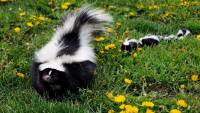User Tools
 ==== Striped Skunk ==== (Mephitis mephitis)
==== Striped Skunk ==== (Mephitis mephitis)
Donated by Wade Cohoon, Jr.
The striped skunk is easy to identify by its black fur and the white stripe, which starts with a triangle at the head then separates into two stripes on its back, and then meets again to make one stripe on the tail. Its size is about the same as a house cat.
This skunk can be found in almost every state in the United States, including Minnesota. Skunks like to live in an area that has a mix of grasslands and woods. Striped skunks mate between mid-February and mid-March. They have five to six babies two months later. The babies will stay with their mother for up to a year.
They are omnivorous and eat insets, small mammals, fish crustaceans, fruits, nuts, leaves, grasses, and dead animals. Their diet really depends on what they can find at the time.
As most people know skunks have a rather unpleasant defense system. First the skunk will try to run away, then it will turn its back, raise its tail, and stomp its feet, and then, as a last resort, it will spray a very stinky fluid. A skunk can spray as far as twelve feet.
If you see a skunk in Minnesota you generally want to stay away from it, besides the fact that it might spray you with its unpleasant smelling spray, they can also be deadly due to the fact that skunks often carry rabies. In fact the striped skunk carries rabies more than any other mammal in Minnesota.

